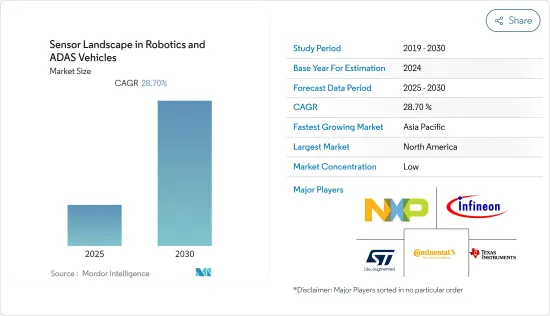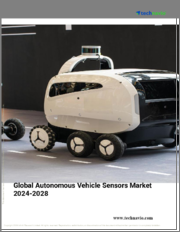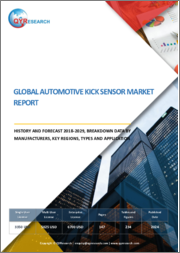
|
시장보고서
상품코드
1683434
세계의 로보틱스 및 ADAS 차량 센서 정세 : 시장 점유율 분석, 업계 동향과 통계, 성장 예측(2025-2030년)Sensor Landscape in Robotics and ADAS Vehicles - Market Share Analysis, Industry Trends & Statistics, Growth Forecasts (2025 - 2030) |
||||||
세계의 로보틱스 및 ADAS 차량의 센서 정세는 예측 기간 동안 28.7%의 연평균 복합 성장률(CAGR)로 추이할 전망입니다.

주요 하이라이트
- 또한 완전자율주행차를 전개하기 위한 연구개발 활동이 활발해지고 있어 차량 주위의 360도의 안전을 가능하게 하는 센싱 기술이 매우 중요합니다. 구글이나 우버와 같은 기업들은 이미 완전자동운전 로봇카를 개발하기 위해 노력하고 있습니다.
- 레이더 센서 시장은 급속한 기술 혁신의 시대이며 전례없는 역동적 인 시장입니다. 예를 들어, 바이탈 사인 드라이버 모니터링 시스템, 섀시에서 지면까지의 모니터링, 핸즈프리 트렁크 오프닝 등 레이더의 새로운 가능성은 계속해서 탄생하고 있습니다. 산업은 지금 레이더 이미징의 가능성을 생각하고 있습니다. 이 기술이 자율주행차나 로봇카, 광고항공에 있어서 중요해지는 것은 틀림없습니다. 예를 들어 2019년 Velodyne은 올랜도에서 열린 심포지엄 행사에서 Alphapuck을 발표했습니다. 이것은 고속도로에서 자율 주행과 고급 차량 안전을 위해 특별히 만들어진 LiDAR 센서입니다. 장거리 고해상도와 넓은 시야의 조합을 실현합니다.
- 충돌 회피 자동 브레이크 시스템 등의 기술을 도입하도록 정부가 의무화하고 있는 것이 시장을 견인하고 있습니다. 마찬가지로 자동차 배출가스 저감을 중시하는 정부는 자동차 및 기타 상용차의 연비를 향상시켜야 하며 압력 센서의 성장을 가져오고 있습니다. 예를 들어 중국 정부는 2020년까지 새로운 배출가스 기준 '6A'를 도입하여 자동차 배출가스를 더욱 줄일 예정입니다.
- 최근 COVID-19가 발생함에 따라 자동차 센서는 세계 각국에서 실시되고 있는 봉쇄 조치에 대응하기 때문에 주요 자동차 제조 공장이 생산을 전면적으로 정지했기 때문에 성장률이 저하되고 있습니다. 게다가 자율주행차는 타격을 받고 자율주행 기술의 도착은 COVID-19에 의한 자동차 판매와 생산의 최근 급격한 악화로 인해 아마 1-2년 늦을 것으로 예상됩니다. 예를 들어 Ford는 COVID-19의 영향을 받아 전략을 재검토하기 위해 자율주행차 생산을 2022년까지 지연시켰습니다.
로봇과 ADAS 차량 시장 상황에서 센서 동향
레이더 센서가 시장 성장을 견인할 전망
- 현재, 안전, 쾌적성, 엔터테인먼트 향상에 중점을 둔 기술 전환기를 맞이하는 자동차 산업은 레이더 센서의 적용에 충분한 기회를 제공합니다. 무인 항공기, 자율 주행 차량, ADAS 용도 등 센서를 많이 사용하는 새로운 용도는 레이더 센서의 필요성을 더욱 가속화하고 있습니다.
- 2020년 11월, GroundProbe는 SSR-Agilis의 출시로 종합적인 경사 안정 레이더(SSR) 제품의 제공을 확대했습니다. SSR-Agilis는 오염의 영향을 받기 어려운 독특한 측정을 제공하는 3D 리얼 애퍼처 레이더입니다.
- 자율/자동 운전 차량의 출현으로 레이더 센서의 채용이 증가하고 있습니다. 예측 기간 동안 기술 혁신은 자동차 산업에서 레이더 센서 수요를 촉진할 것으로 예상됩니다.
- 예를 들어, 2019년 3월, European Commission는 이 지역의 사고 수준을 낮추기 위해 유럽에서 제조되는 자동차에 자율 안전 기술을 필수 요건으로 하는 일반 안전 규칙의 개정을 발표했습니다. 엄격한 규정은 자동차 공급업체에게 최신 레이더 센서 기반 시스템을 도입하도록 촉구하고 있습니다. 이것은 시장에 기회를 가져옵니다.
- 그러나 레이더 센서는 다양한 기능을 가지면서 초기 비용이 높고, 그 비용은 센서 유형, 범위, 도입 기술에 따라 다릅니다. 어떤 레이더 센서의 정확한 가격도 일장일단입니다. 레이더 센서의 비용은 사용하는 센서의 유형, 센서가 적응하는 범위, 센서가 지원하는 용도 등 다양한 요인에 따라 달라지며 총 비용에 번들링됩니다.
북미가 주요 점유율을 차지할 전망
- 북미는 ADAS 지원 차량과 자율주행 교통 솔루션을 채택하는 선구자 중 하나입니다. Deutsche Bank에 따르면 미국의 ADAS 생산량은 2021년까지 1,845만 대에 달할 것으로 전망됐습니다.
- 더 나은 성능을 위해 Google, Uber, Toyota와 같은 유명 기업이 LiDAR을 사용합니다. 동시에 비교적 저렴한 비용으로 Tesla는 자동 운전 차량의 주요 센서로 레이더 센서를 사용하도록 설득하고 있습니다. 각 회사는 시스템의 효율성을 높이기 위해 여러 가지 대체 감지 기술을 차량에 통합하려는 시도를 계속하고 있습니다.
- 이 지역의 유명한 자동차 제조업체(주요 자동차 제조업체 13개 이상), 레이더 센서를 제공하는 공급업체(Bosch, Lockheed Martin 등)는 기술 혁신의 원천으로 상승할 것으로 예상되며 시장에서 중요한 지위를 차지할 것으로 추정됩니다. American Automotive Policy Council에 따르면 지난 5년간 자동차 부문의 수출액은 6,920억 달러에 달했고, 자동차 산업에서만 이 지역의 GDP의 3%에 공헌하고 있으며, 이는 조사 대상 시장의 성장에 효과적으로 기여하고 있습니다.
- 그러나 미국과 중국의 무역전쟁으로 미국 정부는 중국에서 수입되는 자동차 및 자동차 부품에 대한 관세를 최대 25%까지 끌어올릴 계획입니다. 중국은 멕시코에 이어 미국으로 부품 수출국입니다. 미국은 세계 최대의 자동차 시장 중 하나이며, 이러한 관세는 자동차 부문에 영향을 미칠 가능성이 높습니다. 세계무역기구(WTO)에 따르면 이들 국가의 갈등은 세계무역의 3%, 자동차 산업의 8%에 직접 영향을 미친다고 합니다. 이러한 상황은 이 지역의 로봇과 ADAS 차량의 센서 상황에 영향을 미칠 것으로 예상됩니다.
로봇과 ADAS 차량의 센서 상황 산업 개요
로보틱스 및 ADAS 차량의 센서 시장은 Infineon Technologies AG, Continental AG, Texas Instrument Incorporated 등 많은 선도 기업들이 존재하고 분할되어 있습니다. 시장은 급속한 속도로 변화하고 있으며, 내년에는 많은 신기술이 기존 기술에 어려움을 겪을 것으로 예상됩니다. 그러나 기술기업과 자동차 제조업체들은 시장에서의 존재를 확대하고 운전자에게 최고의 안전 기능을 제공하기 위한 연구개발 노력을 강화하고 있습니다.
- 2020년 1월, Continental AG는 미국 텍사스 주 뉴 브라운펠스 시에 새로운 공장을 건설할 것이라고 발표했습니다. 신공장의 건설에 의해 ADAS(선진 운전 지원 시스템)용 레이더 센서의 생산 능력을 확대합니다. 이 회사는 향후 3년간 이 공장에 약 1억 유로를 투자할 계획입니다.
- 2019년 10월, Infineon TechnologiesAG는 자동차용 마이크로컨트롤러 제품군 AURIX에 새로운 멤버를 추가했습니다. TC3A는 ADAS(첨단운전지원시스템) 및 자율주행을 위한 하이엔드 코너 레이더 시스템 등 새로운 차재용 77GHz 레이더 용도에 대응할 가능성이 있습니다.
기타 혜택
- 엑셀 형식 시장 예측(ME) 시트
- 3개월간의 애널리스트 서포트
목차
제1장 서론
- 조사의 전제조건과 시장 정의
- 조사 범위
제2장 조사 방법
제3장 주요 요약
제4장 시장 역학
- 시장 개요
- 산업 밸류체인 분석
- 산업의 매력 - Porter's Five Forces 분석
- 공급기업의 협상력
- 소비자의 협상력
- 신규 참가업체의 위협
- 대체품의 위협
- 경쟁 기업간 경쟁 관계
- 시장 성장 촉진요인
- 근로자의 안전에 대한 의식의 고조와 엄격한 규제
- 아시아태평양의 주요 신흥국에서 산업 부문의 꾸준한 증가와 확대 프로젝트
- 시장의 과제
- 최근의 산업별 COVID-19의 발생과 주요 업종에 있어서의 지출의 약간의 감소가 제조업체에 우려를 가져올 전망
- 경승용차와 로봇카의 자동화 레벨별 판매 통계
- 주요 산업 표준 및 규제
- 자동차용 센서(레이더, 카메라, LiDAR)의 기술 로드맵
- COVID-19의 산업에 대한 영향 평가
제5장 시장 세분화
- 유형
- LiDAR(로봇 차량 대 ADAS 차량)
- 레이더(로봇 차량 대 ADAS 차량)
- 카메라 모듈(로봇 차량 대 ADAS 차량)
- GNSS(로봇 차량)
- 관성 측정 장치(IMU)(로봇 차량)
- 지역
- 북미
- 유럽
- 아시아태평양
- 라틴아메리카
- 중동 및 아프리카
제6장 경쟁 구도
- 자동차용 LiDAR 공급업체 상위 3개사의 벤더 랭킹
- 자동차용 이미지 센서 공급업체 상위 3개사의 벤더 랭킹
- 자동차용 레이더 공급업체 상위 3개사의 벤더 랭킹
- 기업 프로파일
- Infineon Technologies AG
- NXP Semiconductor NV
- Ouster Inc.
- Velodyne LiDAR Inc.
- Luminar Technologies Inc.
- Aurora Innovation Inc.(Blackmore 포함)
- Waymo LLC
- Robert Bosch GmbH
- Continental AG
- Valeo SA
- ON Semiconductor Corp
- Omnivision Technologies Inc.
- ST Microelectronics NV
- Texas Instruments Incorporated
제7장 투자 분석
제8장 시장 기회와 앞으로의 동향
JHS 25.04.01The Sensor Landscape in Robotics and ADAS Vehicles Market is expected to register a CAGR of 28.7% during the forecast period.

Key Highlights
- Also, the increasing research and development activities to roll out fully autonomous cars require sensing technologies that are of great importance to enable 360-degree safety around the vehicle. Companies such as Google and Uber are already working on fully automated robotic cars.
- The Radar Sensor market has never been so dynamic, this market period of rapid technological innovation. New opportunities for radar are still emerging with, for instance, vital-sign driver monitoring systems, chassis-to-ground monitoring, and hands-free trunk opening. The industry is now envisioning radar imaging as a possibility. There's no doubt this technology will be critical in autonomous and robotic cars, ad aviation. For instance, in 2019, Velodyne launched Alphapuck at the Symposium event in Orlando. It is a lidar sensor specifically made for autonomous driving and advanced vehicle safety at highway speeds. It delivers a combination of long-range high resolution and wide field of view.
- Government mandates to install technology such as collision avoiding automatic brake systems are driving the market. Similarly, the emphasis of government to lower vehicle emissions will need cars and other commercial vehicles to be more fuel-efficient, resulting in the growth of pressure sensors. The Chinese government, for example, will introduce the new "6A" emission standard by 2020 to further lower vehicle emissions.
- With the recent outbreak of COVID 19, the Automotive sensor is witnessing a decline in growth due to major automotive manufacturing plants that have entirely stopped their production in response to lockdown being enforced by many countries across the world. Moreover, the self-driving vehicle has taken a hit, and the arrival of autonomous driving tech will be slowed, probably one to two years, because of the recent drastic downturn in auto sales and production due to COVID-19. For instance, Ford delayed its autonomous vehicle production until 2022 to rethink its strategy after the COVID-19 impact.
Sensor Landscape in Robotics and ADAS Vehicles Market Trends
Radar Sensor is Expected to Drive the Market Growth
- The automotive industry, which is presently undergoing a technology transition focusing on increasing safety, comfort, and entertainment, provides ample opportunities for the application of radar sensors. Emerging sensor-rich applications, such as drones, autonomous vehicles, and ADAS applications, are further accelerating the need for radar sensors.
- In November 2020, GroundProbe has extended its comprehensive Slope Stability Radar (SSR) product offering with the release of the SSR-Agilis. The SSR-Agilis is a 3D Real Aperture Radar that provides unique measurements that are less susceptible to contamination, crucial for safety-critical monitoring in high traffic work areas.
- With the advent of autonomous/self-driving cars, increasing the adoption of radar sensors can be witnessed. Over the forecast period, innovations are expected to drive the demand for radar sensors in the automotive industry.
- For instance, In March 2019, the European Commission announced a revision of the General Safety Regulations to make autonomous safety technologies a mandatory requirement for vehicles manufactured in Europe, in a bid to bring down accident levels in the region. Stringent regulations are pushing the automotive vendors to implement the latest radar sensor-based systems. This is creating an opportunity for the market.
- However, radar sensors have high initial costs with diversified functionality, and the cost varies based on the type, range, and technology being deployed for different sensors. Ultimately, the exact price of any radar sensor is unique. The cost for the radar sensor is dependent on a variety of factors, such as the type of sensor used, the range to which the sensor is adapted, and the applications supported by the sensor, which will be bundled into the total cost.
North America is Expected to Hold Major Share
- The North America region is one of the pioneers in adopting ADAS-enabled vehicles and self-driven transportation solutions. According to the Deutsche Bank, the US ADAS unit production volume is expected to reach 18.45 million by 2021.
- Owing to the better performance, prominent companies, like Google, Uber, and Toyota, are using LiDAR. At the same time, the relatively lower cost has persuaded Tesla to use radar sensors as the primary sensors in its self-driving cars. The companies are continuously trying to incorporate multiple alternative sensing technologies in a vehicle to enhance the effectiveness of the system.
- Prominent automakers (over 13 major auto manufacturers), and vendors offering radar sensors (Bosch, Lockheed Martin, among others) in the region are expected to emerge as a source for innovation and is estimated to hold a significant position in the market. According to the American Automotive Policy Council, over the past five years, the exports from the automotive sector were valued at USD 692 billion, and the automotive industry alone contributes to 3% of the region's GDP, which effectively contributes to the growth of the market studied.
- However, due to the trade war among the USA and China, the US government is planning to increase tariffs up to 25% on vehicles and car parts imported from China. China is the second biggest exporter of components to the United States, after Mexico. The United States is one of the largest auto markets in the world, and such tariffs will likely affect the automotive sector. As per the World Trade Organization, the conflict between these countries will directly affect 3% of the global trade and 8% of the automotive industry. Such situations are expected to have an impact on the sensor landscape in robotic and ADAS vehicles in the region.
Sensor Landscape in Robotics and ADAS Vehicles Industry Overview
The market for sensor landscape in robotic and ADAS vehicle is fragmented with the presence of many major players like Infineon Technologies AG, Continental AG, Texas Instrument Incorporated, etc. The market is transforming at a rapid pace, and in the coming year, many new technologies will come to challenge the existing one. However, technology companies and car manufacturers are expanding their market presence and increase their R&D efforts to provide the best safety features to the driver.
- In January 2020, Continental AG announced the construction of a new plant in the city of New Braunfels in the U.S state of Texas. The new building will help it expand its capacity for the production of radar sensors for Advanced Driver Assistance Systems (ADAS). The company plans to invest about €100 million in the plant over the next three years.
- In October 2019, Infineon Technologies AG added a new member to its automotive microcontroller family AURIX. TC3A may address new automotive 77 GHz radar applications, such as high-end corner radar systems for advanced driver assistance systems and automated driving.
Additional Benefits:
- The market estimate (ME) sheet in Excel format
- 3 months of analyst support
TABLE OF CONTENTS
1 INTRODUCTION
- 1.1 Study Assumptions and Market Definition
- 1.2 Scope of the Study
2 RESEARCH METHODOLOGY
3 EXECUTIVE SUMMARY
4 MARKET DYNAMICS
- 4.1 Market Overview
- 4.2 Industry Value Chain Analysis
- 4.3 Industry Attractiveness - Porter's Five Forces Analysis
- 4.3.1 Bargaining Power of Suppliers
- 4.3.2 Bargaining Power of Consumers
- 4.3.3 Threat of New Entrants
- 4.3.4 Threat of Substitutes
- 4.3.5 Intensity of Competitive Rivalry
- 4.4 Market Drivers
- 4.4.1 Rising awareness on worker safety & stringent regulations
- 4.4.2 Steady increase in industrial sector in key emerging countries in Asia-Pacific, coupled with expansion projects
- 4.5 Market Challenges
- 4.5.1 Recent outbreak of COVID-19 and marginal decline in spending in key verticals expected to pose a concern to manufacturers
- 4.6 Light Passenger Car and Robotic Vehicle Sales Statistics by Level of Autonomy ?
- 4.7 Key Industry Standards & Regulations
- 4.8 Technological Roadmap for Automotive Sensors (Radar, Camera & LiDAR)
- 4.9 Assessment of Impact of Covid-19 on the Industry
5 MARKET SEGMENTATION
- 5.1 Type
- 5.1.1 LiDAR (Robotic Vehicles Vs. ADAS Vehicles)
- 5.1.2 Radar (Robotics Vehicles Vs. ADAS Vehicles)
- 5.1.3 Camera Modules (Robotics Vehicles Vs. ADAS Vehicles)
- 5.1.4 GNSS (Robotic Vehicles)
- 5.1.5 Inertial Measurement Units (Robotic Vehicles)
- 5.2 Geography
- 5.2.1 North America
- 5.2.2 Europe
- 5.2.3 Asia Pacific
- 5.2.4 Latin America
- 5.2.5 Middle East and Africa
6 COMPETITIVE LANDSCAPE
- 6.1 Vendor Ranking for Top 3 Automotive LiDAR Suppliers
- 6.2 Vendor Ranking for Top 3 Automotive Image Sensor Suppliers
- 6.3 Vendor Ranking for Top 3 Automotive Radar Supplier
- 6.4 Company Profiles
- 6.4.1 Infineon Technologies AG
- 6.4.2 NXP Semiconductor N.V.
- 6.4.3 Ouster Inc.
- 6.4.4 Velodyne LiDAR Inc.
- 6.4.5 Luminar Technologies Inc.
- 6.4.6 Aurora Innovation Inc. (Incl. Blackmore)
- 6.4.7 Waymo LLC
- 6.4.8 Robert Bosch GmbH
- 6.4.9 Continental AG
- 6.4.10 Valeo SA
- 6.4.11 ON Semiconductor Corp
- 6.4.12 Omnivision Technologies Inc.
- 6.4.13 ST Microelectronics NV
- 6.4.14 Texas Instruments Incorporated


















